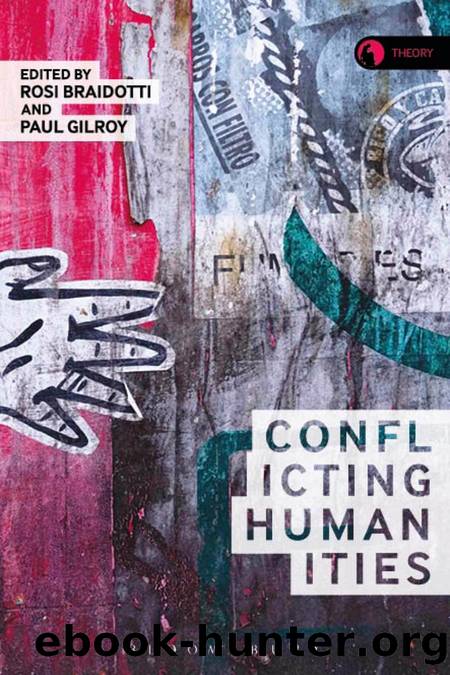Conflicting Humanities by Braidotti Rosi; Gilroy Paul;

Author:Braidotti, Rosi; Gilroy, Paul;
Language: eng
Format: epub
Publisher: Bloomsbury Publishing Plc
Published: 2019-11-27T16:00:00+00:00
3.
Asking the question about who the Palestinians are was, in fact, already part of the answer, part of the process of the development of a national culture that could be self-consciously represented and projected: as Frantz Fanon argued, âTo fight for national culture means in the first place to fight for the liberation of the nationâ (Fanon 1965: 187). The national culture is the struggle, or as Said put it: âOur literature in a certain very narrow sense is the elusive, resistant reality it tries so often to representâ (Said 1986: 38). Ever since, Said and other Palestinians have been producing a body of writing and cultural production, cinema, art, that both defines themselves as Palestinians, and proves it to the world, even the Israelis. Today the lack around Palestinian identity, cultural and historical, that Said laments in 1986 is no longer there â in no small part thanks to Said himself. That generation of cultural capital shows why initiatives such as the West-East Divan orchestra were so important.
In the 1999 interview about the problem of what gets represented and what gets left out, from which I have already cited, Said continues as follows:
In the particular case of the Palestinians, one of our problems is that we donât have any documents to substantiate what we said happened to us. Take one of the Israeli new historians, Benny Morris, for instance. Heâs very literal-minded, and heâs done very important work, but his assumption is that he canât say anything about what happened in 1947â48 unless thereâs a document to show for it. I say, well, why not try to animate that silence? ⦠Why not go through the process of trying to reconstruct out of the silence what was either destroyed or excluded? (Bayoumi and Rubin 2000: 424â5)
That lack of representation has been increasingly answered: for example, the documenting of the Nakba by the historian Ilan Pappe in The Ethnic Cleansing of Palestine (2006), Ahmad Saâdi and Lila Abu-Lighodâs Nakba, 1948, and the Claims of Memory (2007), Nur Masalhaâs The Palestinian Nakba (2011), and the remarkable archive photographs published in Arielle Azoulayâs From Palestine to Israel: A Photographic Record of Destruction and State Formation, 1947â1950 (2007). Whereas in 2001 Gabriel Piterberg could suggest that the claim that there had been an ethnic cleansing of Palestine was still a matter of debate, it has become ever harder to deny.6 Representation no longer seems so distant from historical memory, the concerted attempt since 1948 to make Palestinians unbelong at every level has become ever more fully documented, and is now of course commemorated, every year, around the world on 15 May: Yawm an-Nakba, the day of the catastrophe. And as with the forbidden writing at the UN that produced After the Last Sky which will be read for generations, the more the commemoration is forbidden, the more it will be remembered.
In the same way, whereas in 1986 Said cites what he regards as the tentative beginnings of the literary representations designed âto restore
Download
This site does not store any files on its server. We only index and link to content provided by other sites. Please contact the content providers to delete copyright contents if any and email us, we'll remove relevant links or contents immediately.
| Anthropology | Archaeology |
| Philosophy | Politics & Government |
| Social Sciences | Sociology |
| Women's Studies |
Cecilia; Or, Memoirs of an Heiress — Volume 1 by Fanny Burney(31333)
Cecilia; Or, Memoirs of an Heiress — Volume 3 by Fanny Burney(30934)
Cecilia; Or, Memoirs of an Heiress — Volume 2 by Fanny Burney(30889)
The Great Music City by Andrea Baker(21313)
We're Going to Need More Wine by Gabrielle Union(18073)
Bombshells: Glamour Girls of a Lifetime by Sullivan Steve(13108)
Pimp by Iceberg Slim(12931)
All the Missing Girls by Megan Miranda(12748)
Fifty Shades Freed by E L James(12451)
Norse Mythology by Gaiman Neil(11883)
Talking to Strangers by Malcolm Gladwell(11877)
Crazy Rich Asians by Kevin Kwan(8349)
Mindhunter: Inside the FBI's Elite Serial Crime Unit by John E. Douglas & Mark Olshaker(7834)
The Lost Art of Listening by Michael P. Nichols(6474)
Enlightenment Now: The Case for Reason, Science, Humanism, and Progress by Steven Pinker(6405)
Bad Blood by John Carreyrou(5769)
The Four Agreements by Don Miguel Ruiz(5511)
Weapons of Math Destruction by Cathy O'Neil(5037)
We Need to Talk by Celeste Headlee(4869)
